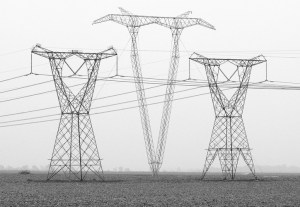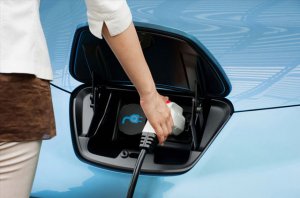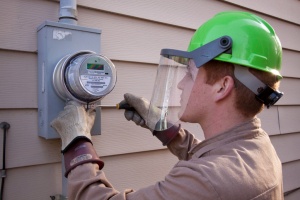
How to build a better electric grid
Dec. 5, 2011 - Ucilia Wang - gigaom.com
 Efforts to modernize the U.S. electric grid in recent
years have emerged in the form of a hodgepodge of
pilot projects, the installation of new technology
and hefty financial backing from the U.S. government
and private investors. How to plan for such a big
change is a daunting task. MIT released a report
on Monday that looks at some of the challenges (and
opportunities for entrepreneurs, investors and utilities)
and solutions to solve them. Efforts to modernize the U.S. electric grid in recent
years have emerged in the form of a hodgepodge of
pilot projects, the installation of new technology
and hefty financial backing from the U.S. government
and private investors. How to plan for such a big
change is a daunting task. MIT released a report
on Monday that looks at some of the challenges (and
opportunities for entrepreneurs, investors and utilities)
and solutions to solve them.
Here are the key challenges:
1). What to do with renewable energy? The growth
of wind and solar power over the past decade has
been one of the biggest drivers of the conversation
about upgrading the aging grid. The grid was originally
designed to handle a steady and one-way flow of electricity
from conventional sources such as coal, natural gas,
nuclear, geothermal and hydro. In contrast wind and
solar power is more likely to enter the grid at different
rates and times throughout the day, depending on
when the sun shines and the wind blows. That intermittency
can cause a lot of problems for the grid, which runs
smoothly only when there is a balance of supply and
demand.
2). Central vs. distributed generation: Many utilities
in the country are counting on large wind and solar
farms to help them comply with their state mandates
to increase the sale of renewable energy. Large power
projects are more likely to be located in remote
regions and require new and costly transmission line
construction. Meanwhile, more solar panels are popping
up on the rooftops of homes and businesses, many
of which feed unused electricity into the grid. This
flow of energy, when it reaches a critical mass,
will require new designs for the distribution lines
and may add costs to consumers’ utility bills.
 3). Electric cars could become popular one
day: While electric cars represent a cleaner alternative
for transportation, utilities also see them as a
potential burden. Consumers have to approach refueling
in different ways than they are accustomed to for
years – they can charge their cars at home,
become members of charging networks and maybe participate
in programs that draw power from their cars’ batteries
to help balance the supply and demand of the electric
grid (and compensate them for this service). Utilities
will have to think about not only when and where
to deliver more power to meet charging demand but
also whether to change electric rates and making
the rates easily accessible by consumers to encourage
charging at off-peak hours. 3). Electric cars could become popular one
day: While electric cars represent a cleaner alternative
for transportation, utilities also see them as a
potential burden. Consumers have to approach refueling
in different ways than they are accustomed to for
years – they can charge their cars at home,
become members of charging networks and maybe participate
in programs that draw power from their cars’ batteries
to help balance the supply and demand of the electric
grid (and compensate them for this service). Utilities
will have to think about not only when and where
to deliver more power to meet charging demand but
also whether to change electric rates and making
the rates easily accessible by consumers to encourage
charging at off-peak hours.
4). Worries about cybersecurity: One of the biggest
changes that is taking place to shape our energy
use is the use of digital communication technology
to allow utilities to monitor and control power supply
and demand and detect problems – and fix them—much
more quickly. The communication technology typically
comes in the form of sensors and high-speed wireless
networks that are built into the distribution grid,
meters, lighting and heating/cooling systems in buildings,
home appliances and electric car chargers. These
devices also are meant to give consumers greater
control over when and how much energy they want to
use in order to reduce costs and increase conservation.
These devices also add complexities to running a
grid and open it up to security breaches, whether
they are malicious or accidental.
MIT’s recommendations:
1). More central planning for transmission: Given
that many wind and solar farms are being built in
remote regions and power producers of these projects
are looking at selling the electricity to utilities
in different states, the Federal Energy Regulatory
Commission should have a greater authority to decide
where interstate transmission lines are built. Right
now FERC has limited authority to review transmission
line proposals, but states are typically the final
decision makers.
 2). Centralize planning process for cybersecurity: Attacks on the grid could cripple not just power
delivery to consumers but also render the country
vulnerable to other attacks. It’s an issue
of national defense and already has been studied
by various government organizations. Given its importance,
the report recommends putting one federal agency
in charge of planning and responding to cybersecurity
issues for the grid, from transmission to distribution
networks. 2). Centralize planning process for cybersecurity: Attacks on the grid could cripple not just power
delivery to consumers but also render the country
vulnerable to other attacks. It’s an issue
of national defense and already has been studied
by various government organizations. Given its importance,
the report recommends putting one federal agency
in charge of planning and responding to cybersecurity
issues for the grid, from transmission to distribution
networks.
3). Match price to power delivery cost: The deployment
of smart meters gives utilities and consumers more
clarity on how much energy is used in each household
and business at any given times throughout the day.
Utilities should use the data to price the electric
rates to reflect the cost of producing or buying
power and sending it to their customers. Doing so
encourages conservation and help consumers reduce
their utility bills, and it enables utilities and
grid operators to anticipate demand and reward companies
that can deliver power and grid regulation services.
The report also recommends that utilities levy a
fixed charge for accommodating the flow of solar
and other renewable energy flowing into the grid
from homes and businesses. The charge would go to
cover the cost of maintaining the grid, and right
now that fee varies depending on the amount of energy
consumption.
4). More research and development – and sharing: Running a grid smoothly requires not just good technologies
but also well thought-out procedures for power producers,
transmission line operators and utilities to ensure
electricity is delivered reliably to each home and
business. It can take years of research and pilot
projects to change or add procedures – the
step-by-step process of how a task is accomplished – in
the industry. So, the power industry needs to pony
up money to fund research and development work in
areas such as computer modeling software, transmission
planning, guides for dealing with and recovering
from cybersecurity breaches and programs to shape
the consumer behavior in energy consumption. And,
it’d be nice to share as much data from research,
demonstration projects and other grid operations
as possible to help build a better grid.

|